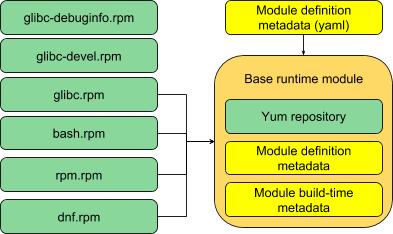(Created page with "We group these binary packages into ''modules''. Note, we can pick just a subset of the subpackages from a particular build into a given module, eg. some hypothetical example ...") |
|||
(No difference)
| |||
Revision as of 14:29, 9 September 2016
We group these binary packages into modules. Note, we can pick just a subset of the subpackages from a particular build into a given module, eg. some hypothetical example base runtime module:
These are internal build groupings: basically repositories, but with additional metadata and semantics that allow them to play nicely with other modules and module tooling.
We attach metadata to these modules, on top of the normal metadata in a repository. That can be support metadata (SLAs or EOL dates for the module); metadata on how to use the module (eg. its dependencies, default installed packages); identity (builder, vendor, version etc), or many other things that we’re still just starting to imagine.
We should be able to update the module as a unit: updating and testing its component parts as necessary, but also testing the module as a whole before releasing an update.
We refer to the assembly of a module by a build tool as a compose. This step includes no compilation; it is merely the creation of a bundled set of packages and metadata comprising a single module. The closest analogue in today’s build system is the “puddle build”, where a custom repository is created for a particular purpose.
When we talk about a module compose, we are not talking about “the Compose” of a full distribution release. The two are similar, in that they both assemble existing compiled packages into bundled output; but the module compose is just one single targeted assembly, whereas the full distribution Compose typically creates multiple repositories and images as output in a single large job. Also note that we can in theory perform the build of the packages within a module, and the compose of the module itself, as a single step; we might term this a module build.

